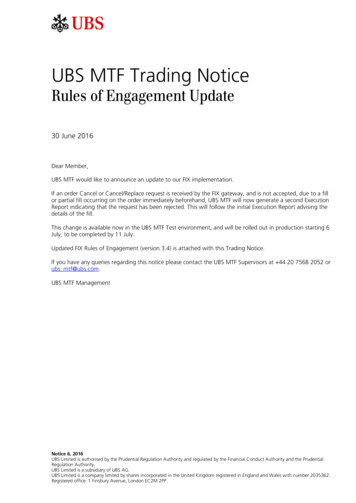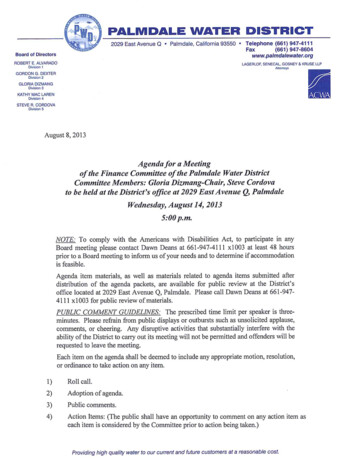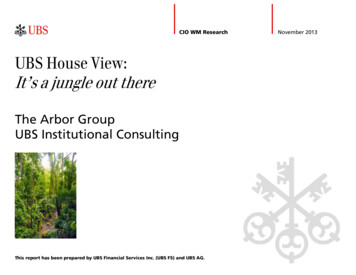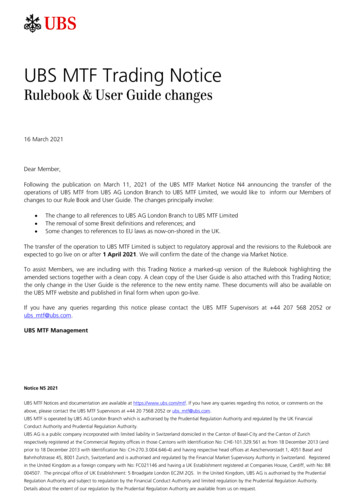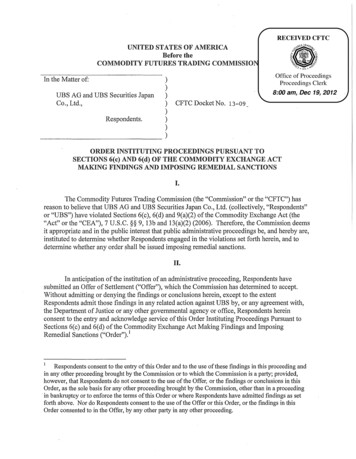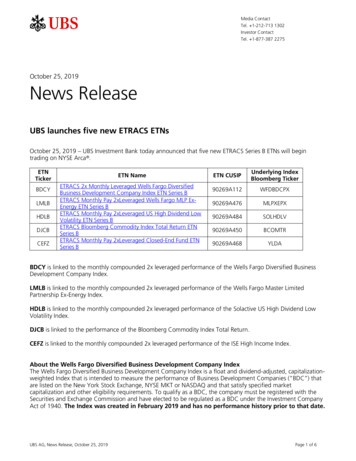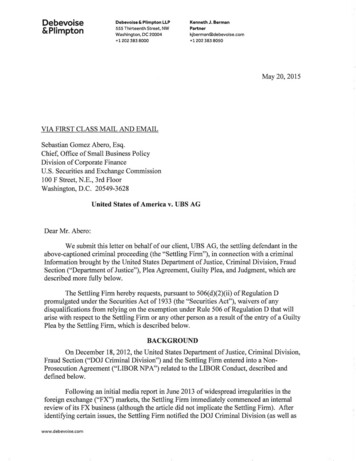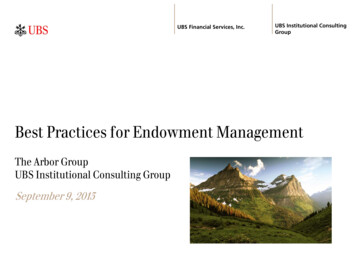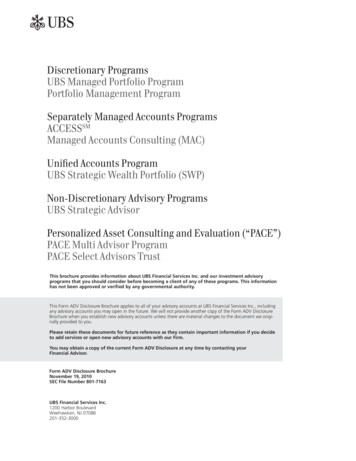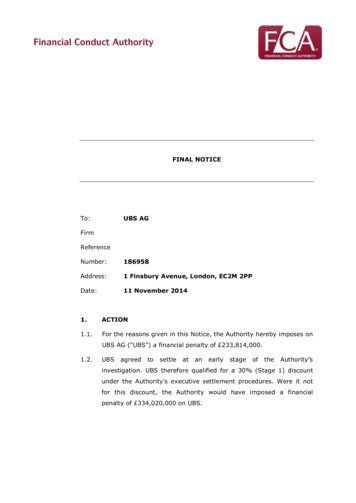
Transcription
FINAL NOTICETo:UBS AGFirmReferenceNumber:186958Address:1 Finsbury Avenue, London, EC2M 2PPDate:11 November 20141.ACTION1.1.For the reasons given in this Notice, the Authority hereby imposes onUBS AG (“UBS”) a financial penalty of heAuthority’sinvestigation. UBS therefore qualified for a 30% (Stage 1) discountunder the Authority’s executive settlement procedures. Were it notfor this discount, the Authority would have imposed a financialpenalty of 334,020,000 on UBS.
2.SUMMARY OF REASONS2.1.The foreign exchange market (“FX market”) is one of the largest andmost liquid markets in the world.1 Its integrity is of centralimportance to the UK and global financial systems. Over a period offive years, UBS failed properly to control its Zurich voice tradingoperations in the G10 spot FX market, with the result that traders inthis part of its business were able to behave in a manner that putUBS’s interests ahead of the interests of its clients, other marketparticipants and the wider UK financial ssandmanageappropriately the risks that their business poses to the markets inwhich they operate and to preserve market integrity, irrespective ofwhether or not those markets are regulated. The Authority alsoexpects firms to promote a culture which requires their staff to haveregard to the impact of their behaviour on clients, other participantsin those markets and the financial markets as a whole.2.3.UBS’s failure adequately to control its Zurich voice trading operationsin the G10 spot FX market is extremely serious. The importance sthroughout the financial system means that misconduct relating to ithas potentially damaging and far-reaching consequences for the G10spot FX market and financial markets generally. The failingsdescribed in this Notice undermine confidence in the UK financialsystem and put its integrity at risk.2.4.UBS breached Principle 3 of the Authority’s Principles for Businessesin the period from 1 January 2008 to 15 October 2013 (“the RelevantPeriod”) by failing to take reasonable care to organise and control itsaffairs responsibly and effectively with adequate risk managementsystems in relation to G10 spot FX voice trading in Zurich. Referencesin this Notice to UBS’s G10 spot FX trading business refer to itsrelevant voice trading desk based in Zurich.2.5.During the Relevant Period, UBS did not exercise adequate andeffective control over its G10 spot FX trading business. UBS relied1The daily average volume turnover of the global FX market was over USD5 trillion in April2013 according to the Bank for International Settlements (BIS) Triennial Central Bank Survey2013.2
primarily upon its front office FX business to identify, assess andmanage risks arising in that business. The front office failedadequately to discharge these responsibilities with regard to obviousrisks associated with confidentiality, conflicts of interest and tradingconduct. The right values and culture were not sufficiently embeddedin UBS’s G10 spot FX trading business, which resulted in it acting inUBS’s own interests as described in this Notice without proper regardfor the interests of its clients, other market participants or the widerUK financial system. The lack of proper control by UBS over theactivities of its G10 spot FX traders in Zurich undermined marketintegrity and meant that misconduct went undetected for a numberof years. UBS’s control and risk functions failed to challengeeffectively the management of these risks in the G10 spot FX tradingbusiness.2.6.UBS’s failings in this regard allowed the following behaviours to occurin its G10 spot FX trading business:(1)Attempts to manipulate the WMR and the ECB fix rates, aloneor in collusion with traders at other firms, for UBS’s ownbenefit and to the potential detriment of certain of its clientsand/or other market participants;(2)Attempts to trigger clients’ stop loss orders for UBS’s ownbenefit and to the potential detriment of those clients and/orother market participants; and(3)Inappropriate sharing of confidential information with tradersat other firms, including specific client identities and, as partof (1) and (2) above, information about clients’ orders.2.7.These failings occurred in circumstances where certain of thoseresponsible for managing front office matters were aware of and/orat times involved in behaviours described above. They also occurreddespite the fact that UBS received whistleblowing reports betweenNovember 2010 and December 2012 which alleged misconduct by FXtraders. Internal reports by UBS in 2011 and 2012 also identifiedsignificant weaknesses and gaps in UBS’s systems and controlsaround market conduct issues.2.8.UBS was on notice about misconduct associated with LIBOR /EURIBOR during the Relevant Period. The Authority issued a Final3
Notice and a financial penalty against UBS on 19 December 2012 inrelation to benchmark setting for LIBOR / EURIBOR.Against thisbackground UBS engaged in an extensive remediation programmeacross its businesses in response to LIBOR / EURIBOR which includedsignificant improvements to its systems and controls relating tosubmissions-based benchmarks. Despite these improvements, thesteps taken during the Relevant Period in its G10 spot FX tradingbusiness did not adequately address the root causes that gave rise tofailings described in this Notice.2.9.The Authority therefore imposes a financial penalty on UBS in theamount of 233,814,000 pursuant to section 206 of the Act.2.10. andassistance provided by UBS during the course of its investigation.The Authority recognises that UBS acted promptly in being the firstfirm to bring the behaviours referred to in this Notice to theAuthority’s attention. UBS is continuing to undertake remedial actionand has committed significant resources to improving the businesspractices and associated controls relating to its FX operations. It hastaken important steps to promote changes to the culture and valuesacross its business. The Authority recognises the work alreadyundertaken by UBS in this regard.2.11. This Notice relates solely to UBS’s conduct in its G10 spot FX tradingbusiness in Zurich. It makes no criticism of any entities other thanthe firms engaged in misconduct as described in this Notice.3.DEFINITIONS3.1.The definitions below are used in this Final Notice.“the Act” means the Financial Services and Markets Act 2000“the Authority” means the body corporate previously known as theFinancial Services Authority and renamed on 1 April 2013 as theFinancial Conduct Authority“the BoE” means the Bank of England“the BIS survey” means the Bank for International Settlements (BIS)Triennial Central Bank Survey 2013“CDSG” means the BoE’s Chief Dealers’ Sub-Group4
“clients” means persons to whom a firm provides G10 spot FX voicetrading services“EBS” means the Electronic Brokerage Service, an electronic brokingplatform“ECB” means the European Central Bank“1:15pm ECB fix” or “ECB fix” is the exchange rate for various spotFX currency pairs as determined by the ECB as at 1:15pm UK time“EURIBOR” means the Euro Interbank Offered Rate“FICC” means Fixed Income, Currencies and Commodities“firms” means authorised persons as defined in section 31 of the Act“FX” means foreign exchange“G10 currencies” means the following currencies:USDUS dollarEUREuroJPYJapanese yenGBPBritish poundCHFSwiss francAUDAustralian dollarNZDNew Zealand dollarCADCanadian dollarNOKNorwegian kroneSEKSwedish krona“LIBOR” means the London Interbank Offered Rate“the ACI Model Code” means the Model Code issued by the ACI – theFinancial Markets Association, as applicable during the RelevantPeriod5
“net client orders” has the meaning given to that term at paragraph3.2 of Annex B to this Notice“the NIPS Code” means the Non-Investment Products Code, asapplicable during the Relevant Period“the Principles” means the Authority’s Principles for Businesses“Reuters” means the Reuters Dealing 3000, an electronic brokingplatform operated by Thomson Reuters“the Relevant Period” means 1 January 2008 to 15 October 2013“spot FX” has the meaning given to that term in paragraph 4.3 of thisNotice“the spot FX rate” means the current exchange rate at which acurrency pair can be bought or sold“the Tribunal” means the Upper Tribunal (Tax and ChanceryChamber)“the UK financial system” means the financial system operating in nges,regulated activities and other activities connected with financialmarkets and exchanges“4pm WM Reuters fix” or “WMR fix” is the exchange rate for variousspot FX currency pairs determined by WM Reuters as at 4pm UK time4.FACTS AND MATTERSRelevant backgroundThe FX market4.1.The FX market, in which participants are able to buy, sell, exchangeand speculate on currencies, is one of the largest financial markets inthe world. Participants in the FX market include banks, commercialcompanies, central banks, investment management firms, hedgefunds and retail investors.4.2.The most significant currencies traded in the FX market are G10currencies in terms of turnover and their widespread use withinglobal financial markets. According to the BIS survey, almost 75% ofall global FX trading in April 2013 was conducted in G10 currencypairs, with a daily average turnover of almost USD4 trillion. The top6
currencies by daily volume of FX trading in April 2013 were US dollar,Euro, Japanese yen and British pound, with the largest turnover inEUR/USD, USD/JPY and GBP/USD currency pairs.4.3.The FX market includes transactions involving the exchange ofcurrencies between two parties at an agreed rate for settlement on aspot date (usually two business days from the trade date) (“spotFX”). Benchmarks set in the spot FX market, especially in G10currency pairs, are used throughout the world to establish therelative values of different currencies and are of crucial importance inworldwide financial markets. In particular, benchmarks such as the4pm WM Reuters and 1:15pm ECB fixes are used in the valuation andperformance management of investment portfolios held by pensionfunds and asset managers both in the UK and globally. The ratesestablished at these fixes are also used as reference rates in financialderivatives.4.4.A fuller description of the spot FX market and the backgroundmatters described below is set out in Annex B to this Notice.The 4pm WM Reuters fix and the 1:15pm ECB fix4.5.Two of the most widely referenced spot FX benchmarks are the 4pmWM Reuters fix and the 1:15pm ECB fix, which are each used todetermine benchmark rates for various currency pairs. For G10currency pairs, these fixes are based upon spot FX trading activity bymarket participants at or around the times of the respective 4pm WMReuters or 1:15pm ECB fixes.Fix orders4.6.Prior to a fix, clients often place orders with a firm to buy or sell aspecified volume of currency “at the fix rate”. This is a reference tothe rate that will be determined at a forthcoming fix and the firmagrees to transact with clients at that rate.4.7.By agreeing to transact with clients at a fix rate that is yet to bedetermined, the firm is exposed to rate movements at the fix. A firmwill typically buy or sell currency in order to manage this risk, forexample by trading in the market or “netting off” (e.g. where a firmhas a buying interest for the fix and trades with a market participantwhich has a selling interest for the fix).7
4.8.A firm with net client orders to buy currency at the fix rate will makea profit if the average rate at which the firm buys the currency in themarket is lower than the fix rate at which it sells to its clients.Similarly, a firm with net client orders to sell currency at the fix ratewill make a profit if the average rate at which it sells the currency inthe market is higher than the fix rate at which it buys from its clients.4.9.A firm legitimately managing the risk arising from its net client ordersat the fix rate may make a profit or a loss from its associated tradingin the market. Such trading can, however, potentially influence thefix rate. For example, a firm buying a large volume of currency in themarket just before or during the fix may cause the fix rate to movehigher. This gives rise to a potential conflict of interest between afirm and its clients. It also creates a potential incentive for a firm toseek to manipulate the fix rate to its benefit and to the potentialdetriment of certain of its clients. For example, there is a risk that afirm with net client orders to buy a particular currency at the fix ratemight deliberately trade in a manner designed to manipulate the fixrate higher. This trading could result in a profit for the firm asdescribed above, but may result in certain clients paying a higher fixrate than they would otherwise have had to pay.Fix Orders – The Bank of England4.10. The Bank of England (“the BoE”) through its membership of the ChiefDealers’ Sub-Group (“CDSG”)2 was made aware during the RelevantPeriod of firms using electronic messaging services, such as chatrooms, to discuss their net orders ahead of fixes and the practice ofnetting off between them. The fact this was happening was raisedwith the BoE by UBS in the spring of 2012. For the avoidance ofdoubt, the Authority does not consider that the netting off of ordersahead of fixes is inappropriate in all circumstances. The Authorityhas concluded that the fact that netting off was discussed by theCDSG does not affect the liability of the firms. Each firm wasresponsible for ensuring that it had appropriate systems and controlsto manage the risks associated with these practices. The BoE hasconducted its own investigation into the role of its officials in relation2The CDSG is a sub-group of the London Foreign Exchange Joint Standing Committeeestablished under the auspices of the BoE. Its membership is drawn from a selection of chiefdealers active in the London FX market and is chaired by a representative of the BoE.8
to certain conduct issues in the FX market which is being publishedseparately.3Stop loss orders4.11. Clients place stop loss orders with a firm to help manage their riskarising from movements in currency rates in the spot FX market. Byaccepting these orders, the firm agrees to transact with the client ator around a specified rate if the currency trades at that rate in themarket. No binding agreement is made until the agreed rate hasbeen “triggered” (i.e. when the currency trades at that rate in themarket).4.12. By agreeing to transact with a client at or around the specified rate,the firm is exposed to movements in the spot FX rate. A firm willtypically buy or sell currency in the market in order to manage thisrisk. This trading can result in a profit or a loss for the firm. Forexample, a client’s stop loss order to buy currency can result in aprofit for the firm if the average rate at which the firm buys thecurrency in the market is lower than the rate at which it sells thecurrency to the client pursuant to the stop loss order.4.13. A firm legitimately managing the risk arising from a client’s stop iskmanagement. There is, however, a potential incentive for a firm tomanipulate the spot FX rate in order to execute stop loss orders forthe firm’s benefit and to the potential detriment of its client. Forexample, a firm with a client stop loss order to buy a esignedtomanipulate the spot FX rate higher in order to trigger the client’sorder at the specified rate. This could result in the firm making aprofit as described above. The client could be disadvantaged,however, since the transaction may not have happened at that timeor at all but for the firm’s actions.Electronic messaging via chat rooms or similar4.14. It was common practice during most of the Relevant Period for G10spot FX traders at firms to use electronic messaging services, such as3The terms of reference of which are available es/news/2014/052.aspx9
chat rooms, to communicate with traders at other firms. Whilst suchcommunications are not of themselves inappropriate, the frequentand significant flow of information between traders at different firmsincreases the potential risk of traders engaging in collusive activityand sharing, amongst other things, confidential information. It istherefore especially important that firms exercise appropriate controland monitoring of such communications.Spot FX operations at UBS4.15. UBS is headquartered in Switzerland. It serves private, institutionaland corporate customers worldwide, as well as retail customers inSwitzerland.4.16. UBS’s global FX business is part of UBS’s Investment Bank. Duringthe Relevant Period there were spot FX trading desks in USA,Singapore and Zurich. According to the Euromoney4 FX Survey 2013,UBS was listed in the top seven firms in terms of market share inglobal FX trading in spot and forwards.4.17. UBS employed a “three lines of defence” model to manage the odel,responsibility for the control environment in the business resided inthe relevant business area’s management (the first line of defence),with support from control functions such as Compliance, Risk andLegal (the second line of defence) and Internal Audit (the third line ofdefence).The failures of systems and controls at UBS4.18. In accordance with Principle 3, UBS was under an obligation toidentify, assess and manage appropriately the risks associated withits G10 spot FX trading business, given the potentially very significantimpact of misconduct in that business on G10 fix benchmarks, thespot FX market generally and the wider UK financial system. UBSfailed to do so adequately during the Relevant Period in relation torisks associated with confidentiality, conflicts of interest and tradingconduct in its G10 spot FX trading business in Zurich.4Euromoney is an English-language monthly magazine focused on business and finance. Firstpublished in 1969, it covers global banking, macroeconomics and capital markets, includingdebt and equity.10
4.19. There are no detailed requirements for systems and controlsconcerning spot FX trading in the Authority’s Handbook. Theimportance of firms implementing effective systems and controls snonetheless recognised within the market, as evidenced by a numberof industry codes published from time to time from 1975 onwards.4.20. recognised:(1)That manipulative practices by firms constituted “unacceptabletrading behaviour” in the FX market;5(2)The need for FX trading management to “prohibit thedeliberateexploitationofelectronicgenerate artificial price behaviour”;(3)dealingsystemsto6The need for firms to manage the conflict of interest betweena firm handling client orders and trading for its own account soas to ensure that “customers’ interests are not exploited” and“the fair treatment of counterparties”;7(4)The importance of firms requiring standards that “strive forbest execution for the customer” when managing clientorders;8 and(5)The fundamental importance of preserving the confidentialityof client information as “essential for the preservation of areputable and efficient market place”.94.21. The key provisions of these codes relevant to the matters in thisNotice are reproduced in Annex C.Failure adequately to identify, assess and manage risks in UBS’s G10spot FX trading business4.22. UBS failed to identify properly or take adequate steps to assess therisks described in this Notice associated with its G10 spot FX tradingbusiness, and to manage them effectively during the Relevant Period.56789Paragraph 1 of Annex CParagraph 1 of Annex CParagraph 1 and 2.1 of Annex CParagraph 1 of Annex CParagraph 2.2 of Annex C11
4.23. UBS’s G10 spot FX trading business involved traders receivingconfidential information regarding, amongst other things, the sizeand direction of its clients’ fix orders and the size, direction and levelof other client orders, including stop loss orders. Whilst receipt anduse of such information for risk management purposes can belegitimate, there is a risk that the information could be improperlyused by those traders to trade for UBS’s benefit and to thedisadvantage of certain of its clients. If disclosed by UBS to traders atother firms, it could also enable those traders improperly to takeadvantage of this information for their firms’ benefit and to thepotential detriment of certain of UBS’s clients, acting either alone orin collusion with G10 spot FX traders at UBS. This gave rise toobvious risks in UBS’s G10 spot FX trading business concerningconflicts of interest, confidentiality and trading conduct. These riskswere exacerbated by the widespread use by UBS’s G10 spot FXtraders of chat rooms to communicate with traders at other firms.4.24. Pursuant to its three lines of defence model, UBS’s front office hadprimary responsibility for identifying, assessing and managing therisks associated with its G10 spot FX trading business. The frontoffice failed adequately to discharge these responsibilities with regardto the risks described in this Notice. The right values and culturewere not sufficiently embedded in UBS’s G10 spot FX tradingbusiness, which resulted in it acting in UBS’s own interests asdescribed in this Notice, without proper regard for the interests of itsclients, other market participants or the wider UK financial system.The lack of proper controls by UBS over the activities of its G10 spotFX traders meant that misconduct went undetected for a number ofyears. Certain of those responsible for managing front office matterswere aware of and/or at times involved in the misconduct.4.25. Whilst UBS had policies in place regarding risks of the type describedin this Notice, they were high-level in nature and applied, in mostcases, to either the whole of UBS or to all FICC employees. Althoughthese policies reflected provisions of the industry codes described atparagraph 4.20 above, there were only limited provisions orexamples that were directly relevant to UBS’s G10 spot FX tradingbusiness. UBSimplementedaCompetitionLawCommunications Framework policy in July 2012.policy andaAlthough these12
policies contained guidance on confidentiality and communicationswith third parties, they did not address fully the behaviours identifiedin this Notice. UBS had general policies regarding the use ofelectronic communications, but UBS did not have any policiesapplicable to its G10 spot FX trading business specifically regardingthe use by traders of chat rooms or similar electronic messagingservices during the Relevant Period. UBS allowed its traders toparticipate in multi-bank chat rooms throughout the Relevant Period.4.26. UBS failed to take adequate steps to ensure that general policiesconcerning confidentiality, conflicts of interest and trading conductwere effectively implemented in its G10 spot FX trading business.There was insufficient training and guidance on how these policiesshould be applied specifically to that business. They contained limitedpractical examples about their application and inadequate guidanceon what amounted to unacceptable behaviour by G10 spot FXtraders. The absence of adequate training and guidance about theapplication of UBS’s general policies to its G10 spot FX tradingbusiness increased the risk that misconduct would occur.4.27. UBS’s day-to-day oversight of its G10 spot FX traders’ conduct wasinsufficient. There was inadequate supervision by UBS of thosetraders’ conduct and use of chat rooms or similar communicationsduring the Relevant Period. None of the systems and controls inUBS’s FX business were adequate to detect and prevent thebehaviours described in this Notice.4.28. UBS’s second and third lines of defence failed to challenge effectivelythe management of these risks by UBS’s front office. During theRelevant Period, UBS did not conduct monitoring of chat rooms inwhich Zurich traders participated. Accordingly, there was no systemin place to identify or prevent inappropriate inter-bank or internalcommunications by UBS’s spot FX desk. The roll-out of an electroniccommunications monitoring system did not begin until after the endof the Relevant Period.4.29. UBS had certain G10 spot FX trade monitoring in place in Zurichduring the Relevant Period, which was not designed to identify thetrading behaviours described in this Notice.13
4.30. UBS’s failure to identify, assess and manage these risks appropriatelyis especially serious given that:(1)Certain of those responsible for managing front office matterswere aware of and/or at times involved in behavioursdescribed in this Notice.(2)UBS was on notice about misconduct associated with LIBOR /EURIBOR during the Relevant Period. The Authority publisheda Final Notice against a firm in relation to LIBOR / EURIBOR inJune 2012. The Authority issued a Final Notice and a financialpenalty against UBS on 19 December 2012 in relation tomisconduct around LIBOR / erthings,significant failings in the management and control of traders’activities by front office businesses at UBS and other firms,including failing to address or adequately control conflicts ofinterest around benchmarks, inappropriate communicationsand other misconduct involving collusion between traders atdifferent firms aimed at inappropriately influencing LIBOR /EURIBOR. The control failings had led to a poor culture in thefront office lacking appropriate ethical standards and resultedin an ineffective first line of defence. They allowed tradermisconduct around LIBOR / EURIBOR to occur undetectedover a number of years.(4)In the course of UBS’s investigation into LIBOR and EURIBOR,UBS undertook a number of projects to assess whether similarissues could arise in relation to other benchmarks. UBSundertook a wide ranging review to identify those benchmarksto which UBS contributed data.This review identified threecategories of benchmark across its business areas, which UBSthen assessed for risk. In relation to LIBOR, UBS redesignedand implemented a new controls architecture.In particularUBS created specific and detailed procedures for use indeterminingbenchmark submissions, anddelineatedthevarious roles involved in the submissions process, from theactual submitter to Compliance.It also issued enhancedpolicy documents setting out its approach to submissionsbased benchmarks.At the same time, UBS was making14
significant attempts to address cultural issues within itstrading businesses.(5)Despite these improvements, UBS failed to address fully in itsG10 spot FX trading business the root causes that gave rise tofailings described in this Notice. For example, the risks aroundconflicts of interest in that business were not addressed byUBS. As a result, UBS did not appropriately mitigate the risksof potential trader misconduct in its G10 spot FX tradingbusiness.(6)In November 2010, a whistleblowing report was submittedregarding potential misconduct in UBS’s FX business. inDecember 2011, in February / March 2012, in October 2012and in December 2012. These concerns alleged that UBS FXtraders were, amongst other things, engaging in parties,disclosing client confidential information and trading on thatinformation. UBS failed adequately to investigate these issuesand to consider the risks of misconduct within the spot FXbusiness.(7)A review by Compliance into market abuse and marketconduct in 2011/2012 identified significant gaps in first eillance across the business. Further, it identified a needto extend UBS’s market abuse policies to the non-regulatedparts of the business (which would include spot FX). An Auditreport undertaken in 2012 also highlighted the significant gapsin monitoring and surveillance by Compliance across UBS’sInvestment Bank and that there was a need to resolve theseissues urgently.Inappropriate trading behaviour and misuse of confidentialinformation4.31. UBS’s failure to identify, assess and manage appropriately the risksin its G10 spot FX trading business allowed the following behavioursto occur in that business:15
(1)Attempts to manipulate the WMR and the ECB fix rates, aloneor in collusion with traders at other firms, for UBS’s ownbenefit and to the potential detriment of certain of its clientsand/or other market participants;(2)Attempts to trigger clients’ stop loss orders for UBS’s ownbenefit and to the potential detriment of those clients and/orother market participants; and(3)Inappropriate sharing of confidential information with tradersat other firms, including specific client identities and, as partof (1) and (2) above, information about clients’ orders.4.32. These behaviours were typically facilitated by means of G10 spot FXtraders at different firms communicating via electronic messagingservices (including chat rooms). These traders formed close, tightknit groups or one-to-one relationships based upon mutual benefitand often with a focus on particular currency pairs. Entry into someof these groups or relationships and the chat rooms used by themwas closely controlled by the participants. Certain groups describedthemselves or were described by others using phrases such as “theplayers” or similar.4.33. The value of the information exchanged between the traders and theimportance of keeping it confidential between recipients was clear toparticipants. When considering whether to invite another trader tojoin a particular group, a UBS trader checked with other traders inthat chat room “
in UBS's G10 spot FX trading business, which resulted in it acting in UBS's own interests as described in this Notice without proper regard for the interests of its clients, other market participants or the wider UK financial system. The lack of proper control by UBS over the activities of its G10 spot FX traders in Zurich undermined market .
